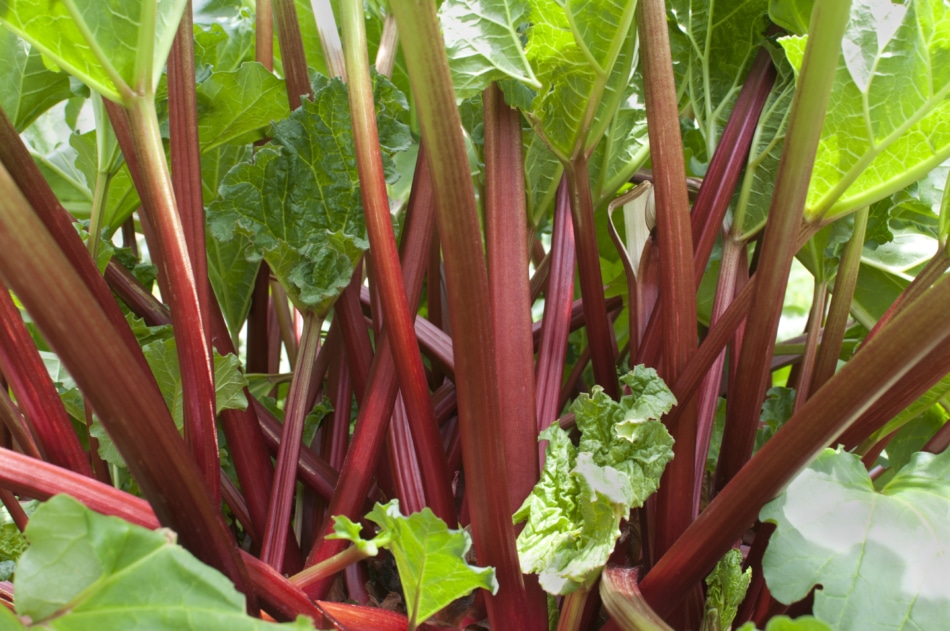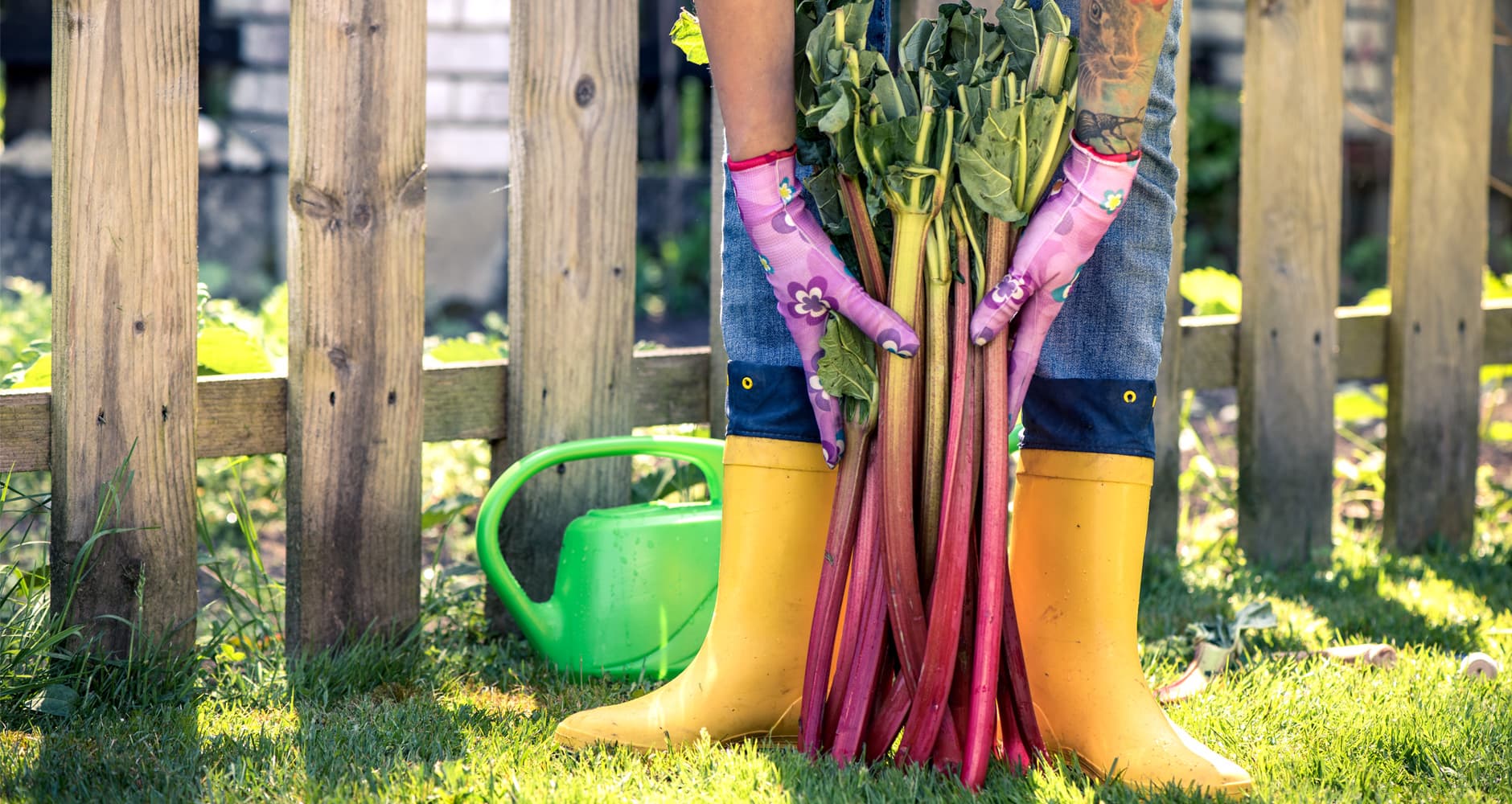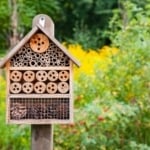Tips For Growing and Harvesting Rhubarb
We've got tips for growing and harvesting this spring favorite

As sure as yellow dandelions show their sunny faces in the spring, unfurling rhubarb leaves herald a season of new growth. The stalks are used to make fabulous pies and jams, and while it is usually prepared as a fruit, this perennial plant is actually a vegetable. If you’ve always wanted to grow rhubarb but were hesitant to give it a try, these tips will definitely help you get started!
Planting Rhubarb

Planting rhubarb is pretty easy, but there are a couple of things to remember. First, you’ll need a spot with well-drained yet fertile soil — the crowns are likely to rot in perpetually moist soil. You can plant these plants in full sun or part shade, but you’ll need to make sure that wherever you plant them, they have at least three or four feet to spread out. As a cool weather plant, rhubarb does well anywhere it can experience wintertime temperatures below 40 degrees (USDA hardiness zones 3 to 8).
Next, remember that when you plant it, do not bury the crown. If you purchased yours at a garden center, this means that you can leave the top of the soil plug exposed. If buried, rhubarb crowns are highly prone to rotting.
In case you’re wondering, it is possible to grow rhubarb from seed, but it may prove a little difficult. First of all, not all seeds will grow to resemble their parent plants, which means that as they grow, you’ll need to pull out the sprouts that aren’t true to type. The other issue is that it will take at least two years before you can harvest. Nevertheless, if you’d like to start your rhubarb from seed, plant them indoors eight to 10 weeks before the final frost. Make sure to plant two seeds per 3-inch pot. This way, the seedlings will have plenty of room to grow before transplanting.
Rhubarb is a carefree plant. If you’ve given it a good place to grow, it won’t need much maintenance at all. The first year, make sure to prune away any flower stems to encourage new growth. After that, you may need to divide the plant every five to 15 years (depending on how quickly it spreads) to make sure that it doesn’t choke itself.
When to Harvest Rhubarb
Really, rhubarb can be harvested any time, but some times are better than others when it comes to the health of your plant. First, if your plant is less than two years old, avoid harvesting it so that it has time to establish itself. For older plants, you can harvest once the stalks are at least 10 inches long. If you choose to harvest when the stalks are shorter, make sure to only take a few stalks at a time so the plant stays healthy throughout the rest of the growing season.
By mid to late summer, you should slow down your harvesting so that the rhubarb plant can start preserving energy to survive over the winter. After July, you can keep picking stalks here or there, but make sure to do so sparingly.
Harvesting Tips
When it’s time to harvest rhubarb stalks, there are two ways to do it. You can either use a sharp knife to cut the stalks near the base of the plant, or you can twist the stalk back and forth until it breaks away from the crown. Make sure that you leave at least a few of the shorter central stalks behind so that the plant can recover.
Important Note: Rhubarb leaves are poisonous, so once you’ve picked the stalks, trim them to remove the leaves. You can toss them out in the trash or compost them, but wherever you dispose of the leaves, make sure that it is somewhere that kids and pets can’t reach.
Using and Preserving Rhubarb
Although rhubarb is a vegetable, it is usually used as a fruit because of its sweet and sour flavor. Make a strawberry rhubarb pie or make rhubarb sauce to pour over vanilla ice cream. It is also commonly used in jams and chutneys.
As much as it is used as a fruit for desserts, it also works well in savory dishes. If you’re feeling adventurous, rhubarb pairs nicely with both salmon and roast pork.
And, if you’re into home food preservation, this is one versatile veggie that is easily canned or frozen. To freeze, simply lay whole or diced stalks out on a cookie sheet lined with parchment paper. Freeze until solid and then place it in appropriately sized bags.
What’s your favorite way to enjoy rhubarb? Share your thoughts in the comments below.
Check out this delicious recipe for a unique marmalade!

Amber Kanuckel
Amber Kanuckel is a freelance writer from rural Ohio who loves all things outdoors. She specializes in home, garden, environmental, and green living topics.







I like to make impossible rhubarb custard pie using Bisquick. I also like making a rhubarb dump cake because it is so easy.
Both sound delicious!
Our 20+ year old rhubarb plant seems to turn out mostly green stalks for rhubarb. How do we get it to develop red stalks?
Rhubarb juice – yummy and a nice change of pace
Add rhubarb sauce to smoothies.
Rubarb stewed and pork chops,, good cookin’
Where do I get the seeds
You can buy them on ebay.
I am moving soon and want to transplant some of my 25 year old rhubarb. It’ll be the same zone but the soil has more sand and clay. Any tips for doing the transplant successfully?
My rhubarb made just such a change quite easily. I believe I enriched the soil a bit but it grew well. I’d make the transplant as quickly as is feasible – not letting the root dry out – and take a good sized chunk if you can.
I am moving soon and wanting to transplant some of my 25 year old rhubarb plant. Any tips on how to this successfully? I’ll be staying in same zone but suspect the new soil will have a greater mix of sand and clay than the current bed does.
Hi Kamile: Carefully dig up the plant with a spade; large plants may be divided into several sections. Each section should have 2 or 3 buds or eyes, and a portion of the roots. Dig a hole, water, place plant in and water regularly. The best time to transplant rhubarb is in early spring before growth begins.
I moved from northeastern Missouri where rhubarb (along with morels) was a favorite. However, I now live east of Tampa, Florida and I was wondering if this would grow in this area.
Rhubarb also makes a very good wine.
I would cut it off simply because those seeds can inadvertently start new rhubarb plants that might not be true to type, which means you’d have to weed them out. Plus, by cutting off the flower stalk, the plant has to devote more energy to making new leaves, which means more rhubarb that you can harvest.
I am curious about what to do with the plant when it develops a TALL middle stalk with booms and seeds?
Should I cut this off, or leave it alone?